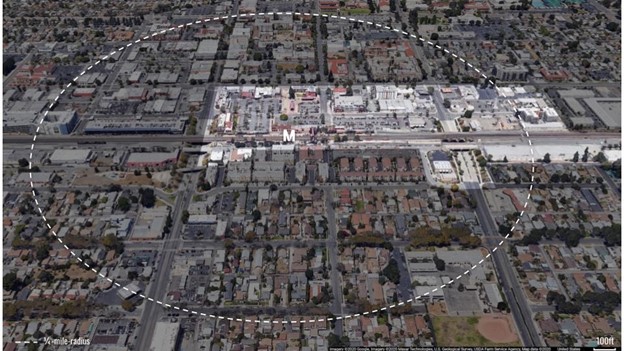News | Transit-Oriented Developments May Be the Answer to Southern California's Housing Crisis: PSR Researchers Examined the Barriers to Affordable Housing and Opportunities Offered by TODs
Stop the VideoNews

Transit-Oriented Developments May Be the Answer to Southern California's Housing Crisis: PSR Researchers Examined the Barriers to Affordable Housing and Opportunities Offered by TODs
Wednesday, September 8, 2021
by Naomi Suzuki and Kieu-Anh Vu

Housing is one of the most pressing barriers to a more equitable future for all California’s residents. The current housing crisis has revealed how vulnerable large segments of society are due to a lack of affordable housing. The California Housing Partnership has determined that California currently has a deficit of about 1.3 million affordable housing units for the lowest income groups.
Examining the nature and extent of the housing crisis in California reveals a host of possible causes: short-sighted development and lack of land use-transportation integration; low-density urban housing developments; increasing gentrification, and uneven funding and investment opportunities. In a study funded by the Pacific Southwest Region University Transportation Center (PSR), USC Professor Emeritus and former James Irvine Chair in Urban and Regional Planning Tridib Banerjee; UC Irvine Associate Professor of Urban Planning and Public Policy Ajay Garde; and Program Director of the USC Center for Economic Development Deepak Bahl examined the barriers to affordable housing as well as opportunities to reduce these barriers through Transit Oriented Developments (TOD). TODs provide convenient, affordable, and reliable mixed use residential developments. The study is titled Increasing Access, Mobility, and Shelter Opportunities for Disadvantaged Populations: Affordable Housing in Transit-Oriented Developments.
TODs are defined as an area of one-half mile radius with a train or bus station at the center (Figure 1). These station areas offer strategic opportunities for new higher-density and mixed-use residential developments with housing for low-income transit-served households. The research team used a mixed-methods, multiple-case study approach involving ten TOD station areas within Los Angeles and Orange Counties. These research sites were selected based on two criteria: first, these communities have a relatively high share of disadvantaged populations, especially low-income and non-white; and secondly, they have actively promoted TODs near rail or bus stations. The research team also conducted semi-structured interviews with affordable and market housing developers, transit and housing planning professionals, and representatives from public agencies. They examined the TOD planning process and the development of affordable housing at the local and state levels in order to clarify the vision, strategy, and goals around TOD principles.
Researchers have identified many benefits of TODs including increased transportation options, gain in household disposable income due to decreased cost of transportation, increased economic development in those areas, and reduced air pollution and energy usage. There is an increasing amount of academic literature on the potential of TODs to provide cost-effective transportation and housing developments that are more eco-friendly and more sustainable than the low-density housing developments currently found in the region. In this study, the research team focused on affordable housing needs and land-use characteristics in the selected station areas and offered recommendations to facilitate affordable housing creation (Figure 1).
Figure 1: Fullerton Transportation Center Metrolink

Source: Google Earth Imagery | Note: Lightened areas correspond to Specific Plan areas
The research team highlights that the improvement of these transit-accessible neighborhoods doesn't automatically solve the overwhelming housing and shelter crisis. TOD designs can appeal greatly to middle class and young professionals who are drawn by opportunities for more affordable housing and the kind of urbanism promoted by TOD designs. This population, however, is not often the one most in need of affordable housing and public transit. Thus, investments in housing and transportation development may lead to rising rents and gentrification, displacing lower-income community residents, further exacerbating socioeconomic inequality. Recognizing the urgency in resolving societal imbalance, the researchers stressed that housing and transport policy should emphasize preserving affordable housing stock and avoiding displacement of low-income residents.
The team, led by Dr. Banerjee, found that a complex and lengthy review process, excessive requirements, and insufficient state and city- level communication create significant barriers to developing fully integrated transit hubs in neighborhoods. The authors make several recommendations to address these barriers including the following:
- Streamline transition of uses from commercial to Residential, by-right, as is done in the City of Los Angeles;
- Reinstate Tax Increment Financing, which subsidizes companies by refunding or diverting a portion of their taxes to help finance development, to promote affordable housing in TOD areas;
- Strengthen institutional capacity for regional collaboration & implementation of relevant State policies;
- Convert park and ride lots in the TOD areas to sites for affordable housing and other community-oriented uses; and
- Minimize time-consuming permit process for affordable housing development in the TOD areas.
The researchers demonstrate the important role that the public sector plays in deciding where affordable housing may be developed. Moreover, the researchers found that affordable housing developers are likely influenced by the availability of resources including incentives that encourage new housing developments in conjunction with transit projects.
About the Authors:
Naomi Suzuki is a graduate student studying Criminology and Criminal Justice in the CSULB College of Health & Human Services. She works as a staff writer for the METRANS News team.
Kieu-Anh Vu is an undergraduate student studying International Business in the CSULB College of Business. She works as a staff writer for the METRANS News team.
Figure 2
Willowbrook: Rosa Parks Green/Blue Line

News Archive
- December (1)
- November (6)
- October (4)
- September (2)
- August (3)
- July (4)
- June (3)
- May (7)
- April (8)
- March (11)
- February (8)
- January (7)
- December (7)
- November (8)
- October (11)
- September (11)
- August (4)
- July (10)
- June (9)
- May (2)
- April (12)
- March (8)
- February (7)
- January (11)
- December (11)
- November (5)
- October (16)
- September (7)
- August (5)
- July (13)
- June (5)
- May (5)
- April (7)
- March (5)
- February (3)
- January (4)
- December (4)
- November (5)
- October (5)
- September (4)
- August (4)
- July (6)
- June (8)
- May (4)
- April (6)
- March (6)
- February (7)
- January (7)
- December (8)
- November (8)
- October (8)
- September (15)
- August (5)
- July (6)
- June (7)
- May (5)
- April (8)
- March (7)
- February (10)
- January (12)















